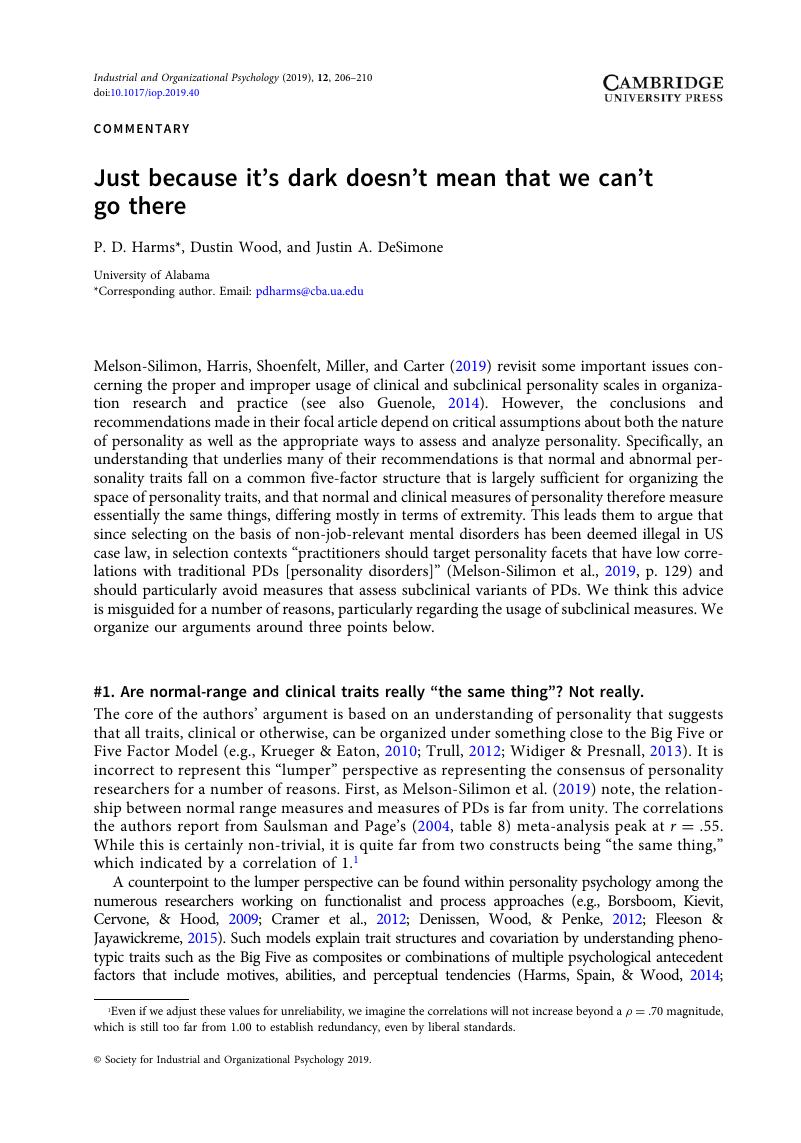No CrossRef data available.
Article contents
Just because it’s dark doesn’t mean that we can’t go there
Published online by Cambridge University Press: 01 August 2019
Abstract
An abstract is not available for this content so a preview has been provided. Please use the Get access link above for information on how to access this content.

- Type
- Commentaries
- Information
- Copyright
- © Society for Industrial and Organizational Psychology 2019
References
Borsboom, D., Kievit, R. A., Cervone, D., & Hood, S. B. (2009). The two disciplines of scientific psychology, or: The disunity of psychology as a working hypothesis. In Valsiner, J., Molenaar, P. C. M., Lyra, M. C. D. P., & Chaudhary, N. (Eds.), Dynamic process methodology in the social and developmental sciences. (pp. 67–97). New York, NY: Springer.CrossRefGoogle Scholar
Cramer, A. O. J., Van der Sluis, S., Noordhof, A., Wichers, M., Geschwind, N., Aggen, S. H., … Borsboom, D. (2012). Dimensions of normal personality as networks in search of equilibrium: You can’t like parties if you don’t like people. European Journal of Personality, 26, 414–431.CrossRefGoogle Scholar
Denissen, J., Wood, D., & Penke, L. (2012). Passing to the functionalists instead of passing them by. European Journal of Personality, 26, 436–437.CrossRefGoogle Scholar
DeSimone, J. A. (2014). Will exploring the darkness prove enlightening? Five questions about the “maladaptive Big Five.” Industrial and Organizational Psychology: Perspectives on Science and Practice, 7, 126–130.CrossRefGoogle Scholar
First, M. B., Gibbon, M., Spitzer, R. L., Williams, J. B. W., & Benjamin, L. S. (1997). SCID-II personality questionnaire. Washington, DC: American Psychiatric Press.Google Scholar
Fleeson, W., & Jayawickreme, R. (2015). Whole trait theory. Journal of Research in Personality, 56, 82–92.CrossRefGoogle ScholarPubMed
Gaddis, B., & Foster, J. (2013). Meta-analysis of dark side personality characteristics and critical work behaviors among leaders across the globe: Findings and implications for leadership development and executive coaching. Applied Psychology: An International Review, 64, 25–54.CrossRefGoogle Scholar
Grijalva, E., Harms, P. D., Newman, D., Gaddis, B., & Fraley, R. C. (2015). Narcissism and leadership: A meta-analytic review of linear and nonlinear relationships. Personnel Psychology, 68, 1–47.CrossRefGoogle Scholar
Guenole, N. (2014). Maladaptive personality at work: Exploring the darkness. Industrial and Organizational Psychology: Perspectives on Science and Practice, 7, 85–97.CrossRefGoogle Scholar
Harms, P. D., Spain, S. M., & Hannah, S. T. (2011a, April). You underestimate the power of the dark side: The Big Five, subclinicals, and job performance. Poster presented at the 26th Annual Conference of the Society for Industrial and Organizational Psychology, Chicago, IL.CrossRefGoogle Scholar
Harms, P. D., Spain, S., & Hannah, S. (2011b). Leader development and the dark side of personality. Leadership Quarterly, 22, 495–509.CrossRefGoogle Scholar
Harms, P. D., Spain, S., & Wood, D. (2014). Mapping personality in dark places. Industrial and Organizational Psychology: Perspectives on Science and Practice, 7, 122–125.CrossRefGoogle Scholar
Hogan, R., & Hogan, J. (2001). Assessing leadership: A view from the dark side. International Journal of Selection and Assessment, 9, 40–51.CrossRefGoogle Scholar
Krueger, R., & Eaton, N. (2010). Personality traits and the classification of mental disorders: Toward a more complete integration in DSM-5 and an empirical model of psychopathology. Personality Disorders: Theory, Research, and Treatment, 1, 97–118.CrossRefGoogle Scholar
Krueger, R. F., Eaton, N. R., Derringer, J., Markon, K. E., Watson, D., & Skodol, A. E. (2011). Personality in DSM-5: Helping delineate personality disorder content and framing the metastructure. Journal of Personality Assessment, 93, 325–331.CrossRefGoogle ScholarPubMed
Landay, K., Harms, P. D., & Credé, M. (2019). Shall we serve the dark lords? A meta-analytic review of psychopathy and leadership. Journal of Applied Psychology, 104(1), 183–196.CrossRefGoogle Scholar
Lilienfeld, S. O. (1994). Conceptual problems in the assessment of psychopathy. Clinical Psychology Review, 14, 17–38.CrossRefGoogle Scholar
Meehl, P. E. (1957). When shall we use our heads instead of the formula? Journal of Counseling Psychology, 4, 268–273.CrossRefGoogle Scholar
Melson-Silimon, A., Harris, A. M., Shoenfelt, E. L., Miller, J. D., & Carter, N. T. (2019). Personality testing and the Americans with Disabilities Act: Cause for concern as normal and abnormal personality models are integrated. Industrial and Organizational Psychology: Perspectives on Science and Practice, 12(2), 119–132.CrossRefGoogle Scholar
Murphy, R. (2018, May 26). Psychopathy by U.S. state. Available at SSRN: https://ssrn.com/abstract%3D3185182 or http://dx.doi.org/10.2139/ssrn.3185182
CrossRefGoogle Scholar
Neo, B., Sellbom, M., Smith, S. F., & Lilienfeld, S. O. (2018). Of boldness and badness: Insights into workplace malfeasance from a triarchic psychopathy model perspective. Journal of Business Ethics, 149, 187–205.CrossRefGoogle Scholar
Oldham, J. M. (2015). The alternative DSM-5 model for personality disorders. World Psychiatry, 14, 234–236.CrossRefGoogle ScholarPubMed
Patrick, C. J., Fowles, D. C., & Krueger, R. F. (2009). Triarchic conceptualization of psychopathy: Developmental origins of disinhibition, boldness, and meanness. Development and Psychopathology, 21(3), 913–938.CrossRefGoogle ScholarPubMed
Saulsman, L. M., & Page, A. C. (2004). The five-factor model and personality disorder empirical literature: A meta-analytic review. Clinical Psychology Review, 23, 1055–1085.CrossRefGoogle ScholarPubMed
Scherer, K., Baysinger, M., Zolynsky, D., & LeBreton, J. (2013). Predicting counterproductive work behaviors with sub-clinical psychopathy: Beyond the five factor model of personality. Personality and Individual Differences, 55, 300–305.CrossRefGoogle Scholar
Spain, S. M., Harms, P. D. & LeBreton, J. (2014). The dark side of personality at work. Journal of Organizational Behavior, 35, 41–60.CrossRefGoogle Scholar
Trull, T. (2012). The Five-Factor Model of personality disorder and the DSM-5. Journal of Personality, 80, 1697–1720.CrossRefGoogle ScholarPubMed
Widiger, T., & Presnall, J. (2013). Clinical application of the Five-Factor Model. Journal of Personality, 81, 515–527.CrossRefGoogle ScholarPubMed
Wood, D., Gardner, M. H., & Harms, P. D. (2015). How functionalist and process approaches to behavior can explain trait covariation. Psychological Review, 122, 84–111.CrossRefGoogle ScholarPubMed
Wood, D., & Harms, P. D. (2016). On the TRAPs that make it dangerous to study personality with personality questionnaires. European Journal of Personality, 30, 327–328.Google Scholar




